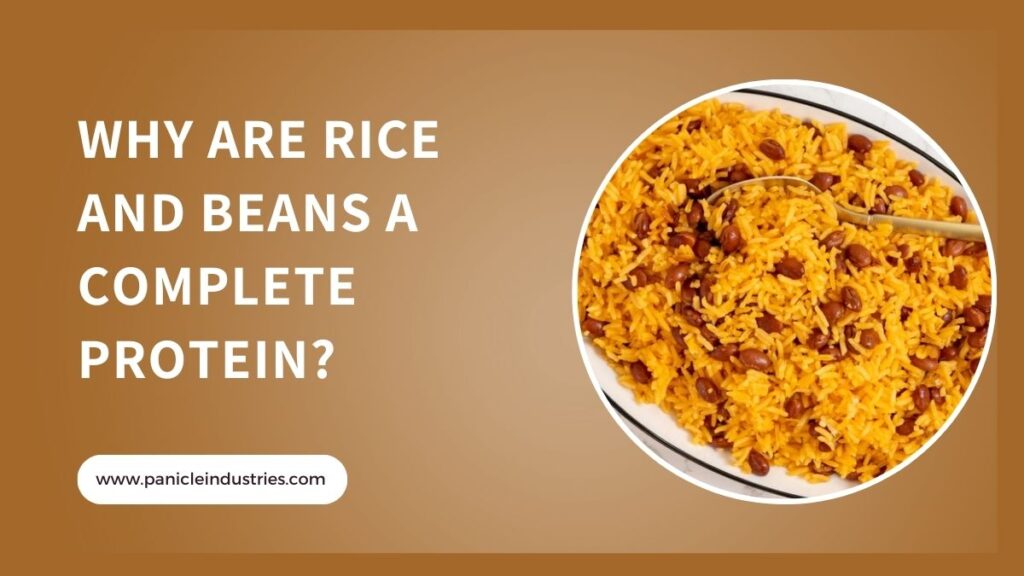Many people often wonder, “Why are rice and beans a complete protein?” The answer lies in the way these two foods work together to provide all the essential amino acids that our body needs. Proteins are the building blocks of life, and they are made of amino acids. Some amino acids are produced naturally in the body, while others, called essential amino acids, must come from food. Rice alone or beans alone cannot provide all the essential amino acids, but when eaten together, they form a complete protein. This makes rice and beans a healthy, affordable, and nutritious meal option enjoyed in many cultures around the world.
In this blog, we will explain how this combination benefits the body.
What is a Complete Protein?
A complete protein is a food that contains all nine essential amino acids in proper amounts. These amino acids are vital for muscle repair, energy, immune function, and overall growth. Animal-based foods like meat, eggs, and dairy are usually complete proteins. However, plant-based foods often lack one or more essential amino acids. That is why combining certain plant foods, like rice and beans, is important for vegetarians and vegans to meet their protein needs.
Also read: Why Rice and Curd is Your Perfect Summer Meal?
Rice as a Source of Protein
Rice is one of the most common foods in the world. While it is mainly rich in carbohydrates, it also contains some protein. However, rice is low in an essential amino acid called lysine. This means rice alone is not a complete protein. Still, it provides quick energy and is very easy to digest, making it a perfect base food to combine with beans.
Beans as a Source of Protein
Beans are rich in protein, fiber, and many vitamins and minerals. However, beans are low in another essential amino acid called methionine, which rice contains in good amounts. This is why beans alone also do not qualify as a complete protein. But when combined with rice, the amino acids from both foods complement each other, forming a complete protein meal.
Why Are Rice and Beans a Complete Protein?
The main reason why rice and beans are a complete protein is because they fill in each other’s nutritional gaps. Rice lacks lysine but has methionine, while beans lack methionine but have lysine. When you eat them together, your body gets all nine essential amino acids in the right balance. This makes the combination of rice and beans as nutritionally powerful as animal-based protein sources like meat or eggs.
Benefits of Eating Rice and Beans Together
- Complete Protein: Provides all nine essential amino acids.
- Affordable Nutrition: Both rice and beans are inexpensive and widely available.
- High in Fiber: Supports digestion and keeps you full for longer.
- Sustainable Choice: Plant-based proteins are environmentally friendly.
- Versatile Meal: Can be cooked in many different ways across cultures.
Cultural Importance of Rice and Beans
Rice and beans are not just nutritious; they are also a cultural staple in many parts of the world.
- In Latin America, rice and beans are eaten daily with spices and vegetables.
- In India, lentils and rice are combined in dishes like khichdi or dal chawal.
- In Africa, rice and beans form a simple, hearty meal for families.
- In the Caribbean, rice and beans are flavored with coconut milk and herbs.
These cultural dishes highlight the global importance of this powerful food combination.
Health Benefits of Rice and Beans
- Supports Muscle Growth: Complete protein helps in repairing and building muscles.
- Boosts Energy: Rice provides quick energy, while beans offer long-lasting energy.
- Good for Digestion: The fiber in beans helps in maintaining a healthy gut.
- Controls Weight: The meal is filling, which helps prevent overeating.
- Balances Blood Sugar: Beans slow down the digestion of rice, making it a balanced meal for blood sugar control.
Rice and Beans for Vegetarians and Vegans
For people who avoid meat, dairy, or eggs, getting complete protein can sometimes be difficult. Rice and beans together offer an excellent plant-based alternative to animal protein. By including this combination regularly, vegetarians and vegans can easily meet their protein needs without relying on expensive supplements or animal products.
How to Prepare Rice and Beans for Best Nutrition
- Use brown rice instead of white rice for more fiber and nutrients.
- Soak beans before cooking to make them easier to digest.
- Add vegetables and spices to make the dish more flavorful.
- Use minimal oil to keep the meal light and healthy.
- Pair with fresh salad or yogurt for a balanced plate.
Are Rice and Beans Enough for Daily Protein?
Rice and beans can meet a large part of your protein needs, especially if eaten in good portions. However, it is still important to include other protein sources like nuts, seeds, dairy, or soy for variety. A balanced diet with different protein-rich foods ensures the body receives all nutrients in the right amounts.
Common Misconceptions
- Myth: Rice and beans must be eaten in the same meal to form a complete protein.
Fact: They do not have to be eaten together. Eating them within the same day is enough for the body to combine the amino acids. - Myth: Only animal foods provide complete proteins.
Fact: Plant-based foods like rice and beans can also provide complete protein when paired correctly.
Why Nutritionists Recommend Rice and Beans
Nutritionists recommend rice and beans because they are nutritious, filling, and affordable. They are especially useful in communities where meat and other high-protein foods are not easily accessible. By including rice and beans in daily meals, people can enjoy a balanced diet that supports health and energy without spending much.
A Sustainable Food Choice
Eating rice and beans is not just good for health but also for the planet. Plant-based proteins require less water and land compared to animal farming. Choosing meals like rice and beans can help reduce environmental impact while still providing complete nutrition.
Conclusion
The question, “Why are rice and beans a complete protein?” can be answered simply: because they complement each other perfectly. Rice provides methionine but lacks lysine, while beans provide lysine but lack methionine. Together, they form a complete protein with all nine essential amino acids. This makes them an affordable, nutritious, and balanced meal option that supports muscle growth, digestion, and overall health.
Rice and beans are enjoyed in many cultures, proving their value both in taste and nutrition. By adding this simple combination to your diet, you can enjoy the benefits of complete protein in a plant-based, sustainable, and delicious way.


